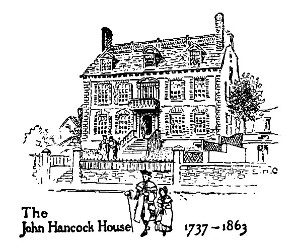|
BOSTON:
A GUIDE
BOOK

BY
EDWIN
M. BACON
WITH ILLUSTRATIONS AND MAPS

GINN
&
COMPANY, PUBLISHERS
29 BEACON STREET, BOSTON
The
Athenæum
Press
COPYRIGHT
1903
BY GINN & COMPANY
GINN
&
COMPANY
The
Athenæum Press
BOSTON:
NEW YORK: CHICAGO
LONDON: SAN FRANSICO
ATLANTA: DALLAS
COLUMBUS

THE HOOKER MONUMENT AND
BULLFINCH FRONT OF THE STATE HOUSE
PUBLISHERS’
NOTE
The
chief merit of any guide is that it brings the history of its subject
to the present moment. Such has been the intent in the preparation of
this little book. It is something more than a guide book to Boston:
it is an historical itinerary, a progress from past to present. Its
scope embraces, besides the municipality of Boston proper, the
various communities which are comprehended in the term
“Greater
Boston”; historical places and literary shrines beyond these
limits, as Salem, Plymouth, and Concord; the North Shore and the
South Shore of Massachusetts Bay. Care has been taken to provide the
visitor with every possible aid to the convenient and comfortable
exploration of the territory treated. Diagrams and trip maps are
scattered through the pages; the typographical arrangement, with the
use of varied types to emphasize places, points, and objects, is
designed to make the material available for quick reference; the text
is profusely illustrated; and at the back of the book are a series of
plate maps, printed in colors to render them the more distinct in
detail. In the mechanical execution the publishers have endeavored to
present a tasteful book, in shape and appearance convenient and
attractive. It is intended in all respects to be the standard Boston
Guide Book.
Among
the distinctive and superior features of this guide are the
following:
1.
The material is original and has been obtained by reference to
original sources and documents. For this reason this guide is
especially authoritative and trustworthy.
2.
The eight pages of color maps at the back of the book, and the
numerous diagram maps inserted in the text, provide unusually
adequate map material, at once convenient and exhaustive. Those who
are accustomed to spread out in the wind the large folder maps
commonly to be found in guide books of this character will doubtless
appreciate the superiority of these small sectional maps and
diagrams.
3.
In other respects the guide is made most convenient. A helpful table
of contents, the logical arrangement of the material, the running
titles, and above all a complete alphabetical index, attain this end
to an admirable degree. Strangers will find the section entitled
“The
Way About Town” (pp. v to viii) particularly valuable.
|

